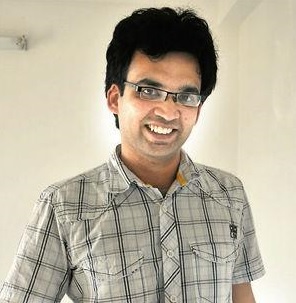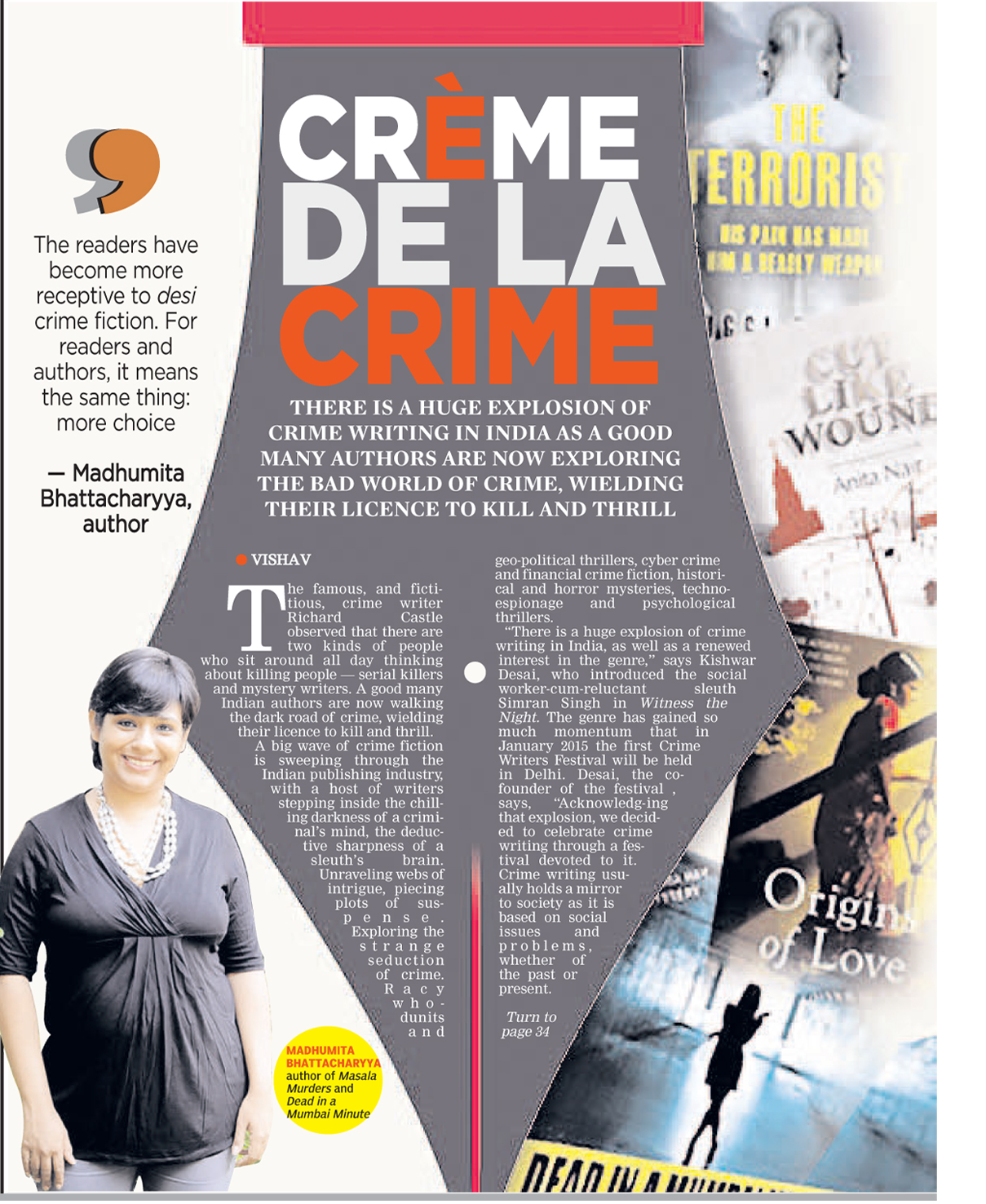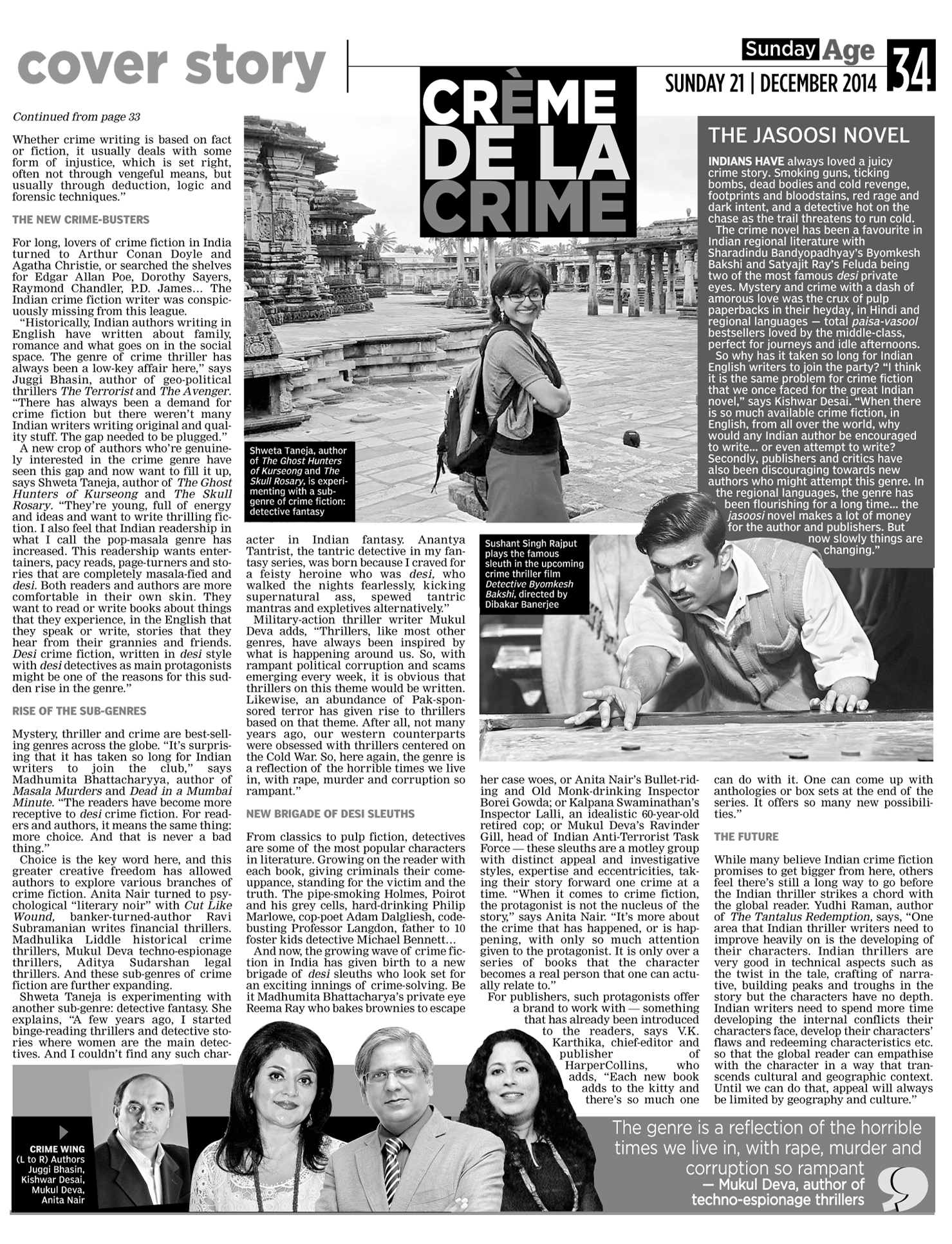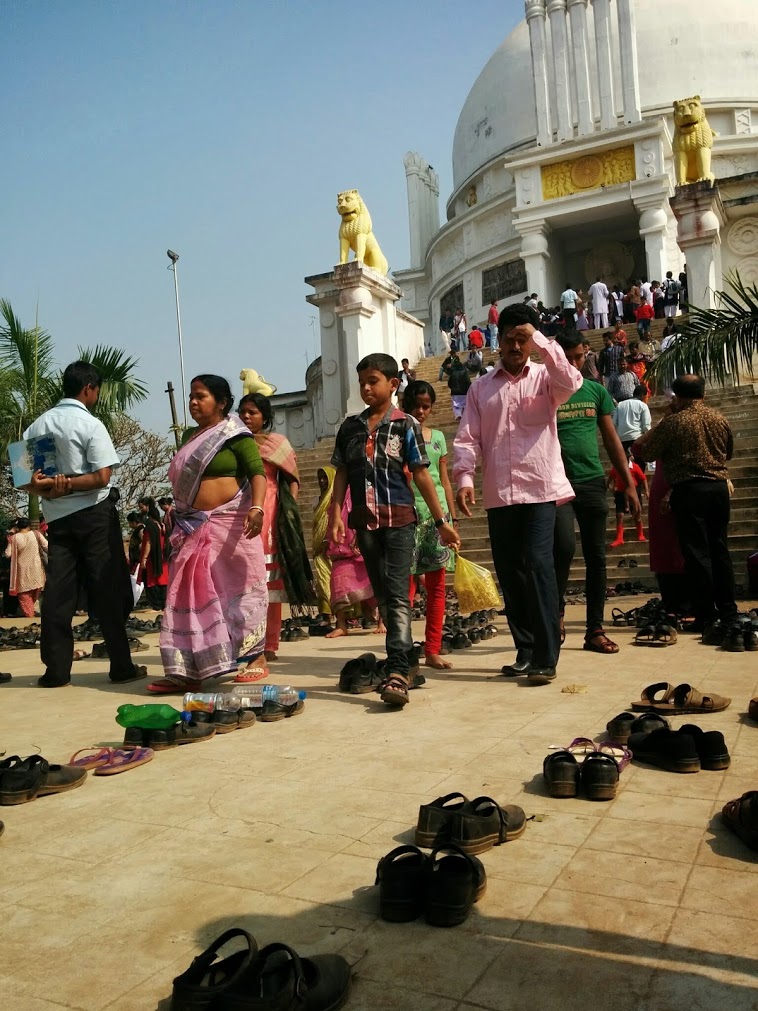Guest post: Four commandments of narrative
 Since last year, I’ve been interacting with author Sharath Komarraju who has become a guide and a friend over Google chat. He furiously pens down books and blogs on writing, mythology as well as money. Here’s his fab post on narrative. Take his advice, he’s good.
Since last year, I’ve been interacting with author Sharath Komarraju who has become a guide and a friend over Google chat. He furiously pens down books and blogs on writing, mythology as well as money. Here’s his fab post on narrative. Take his advice, he’s good.
Fiction is made of two kinds of writing: narrative and dialogue. That is the most simple classification one could make; some would say narrative is different from description which is different from exposition and so on, but for me that ís splitting hairs. There is the stuff with speech, and there is the stuff without. Easy. In this post I am going to tell you some golden rules of writing narrative.
- Write in Active Sentences
This is the first leap out of the comfort zone that a writer must take. It sounds redundant to mention that fiction should be full of action, but you will be surprised if you go back and read your work to find how many ‘inactive’ sentences you’ve written. The problem is that in our speech and in other forms of writing, the active voice is not mandatory and is rarely used, so we fall into this cozy world of weak verbs and passive sentences. This is the main reason why writers who begin writing fiction find that their work lacks strength. It is because they do not use the active voice enough.
One thing I always aim to do when I sit down to write a story is to make every sentence I write an active sentence. Every time I am tempted to write something blasphemous like ‘There was a row of trees on both sides of him’, I slap myself on the wrist and change it to ‘A row of trees stood on both sides of him’. Remember, active sentences use strong verbs, and the more of them you use, the more polished your narrative becomes.
- Include specific, sensory detail
Sight, sound, smell, touch and taste – these are the five means through which we perceive the world around us. When you go to a flower garden and sit down on a bed of roses, you don’t just feel the softness of the petals on your fingers. You hold it up to your nose and it reminds you of the first time you got tickled by the rose in your mother’s hair when she carried you to bed. The spotless white (or is it red?) for some reason makes you want to prick the ball of your thumbs with a needle and squeeze out a drop of fresh blood just to watch it fall on the petal and dissolve into a baby pink spot. When you snap the stem of the rose in two, it sounds very much like your arm did all those years ago when you got pushed down a flight of stairs.
This kind of detail is the lifeblood of fiction. Your characters are human beings like you, and like you they will sense things wherever they go and whatever they do. With each sensory input they will make associations that will link them to their pasts, and they will make decisions that will influence their futures. This is where as a writer you find your voice, in the details that you notice, in the things you show your readers, in the images you build for them.
This is another skill that can be developed with practice. One thing I like to do is think of an item in terms of senses that we generally don’t associate it with. For instance, can you describe the sound of a petal being plucked from a flower? Or the touch of a jalebi on your hand when you pick it up?
- Take care with adjectives and adverbs
With adverbs the rule is simple: do not use them. As a beginning writer, tell yourself not to use adverbs at all in your writing. What this will do is force on you the responsibility of choosing the right verb. Also, what an adverb does is the opposite of what we think it does. We think it will make the meaning clearer and the writing tighter, but in practice it just makes your sentences longer without adding anything of value. The easiest way to make your writing tighter is to run through your first draft and cut out every adverb that you’ve used. (And by adverbs, I mean the words that end in ‘ly’, those things that claim to describe the verb.)
With adjectives it’s hard to be so autocratic, so I won’t say don’t use them at all. But do make your choice wisely. Ninety-nine times out of a hundred, opt for the descriptive adjective over the emotive or judgmental one. So words like ’round’, ‘pale’, ‘thin’, ‘stocky’, ‘soft’ and ‘white’ are to be preferred over words like ‘happy’, ‘sad’, ‘good’, ‘selfish’and so on. Any adjective that builds the image youíre trying to plant in your readerís head is good. Any adjective that tells the reader what to think is bad.
- Be invisible
I cannot emphasize this enough. As a story-teller, your most basic responsibility is to maintain the fictive dream, to make your reader lose himself in your world. I know the temptation to slip in a wisecrack here or an aphorism there, but by all means, whatever you do and however you do it, resist it. Accept that if you write fiction, you will be in the background most of the time. You’re writing about your characters; let them take center-stage. Focus on their experiences, their wants, their struggles. You’re just a story-teller. Stay out of sight. Don’t worry. Your readers wonít miss you.
If you’re thinking why I’ve not included the much-repeated adage, ‘Show, don’t tell’ here, it is because showing and not telling happens as a consequence of writing well. It’s not a technique by itself. If you follow the above four guidelines in your narrative; if you write sensually, if you write in strong, active sentences, if you write tightly, if you remember to be invisible and allow your story to take the spotlight, you wonít have to worry about showing and not telling. It will happen as if on its own. I guarantee it.
For more from Sharath, check out his site
How to remove that awkward feeling while exercising
Many of us feel embarrassed about exercising because our bodies are less than perfect. Here’s how you can face those fears
Adhiraj Singh, 26, an assistant editor in a children’s magazine based in Mumbai, is cripplingly conscious about his man-boobs and the way his tummy jiggles when he jogs. “I just don’t like shaking it all up in front of strangers,” he says. It’s the reason he tried swimming instead. “I thought maybe under the water I can hide and avoid making eye contact.” But that hasn’t helped either, he has to wait for the showers to empty out completely before he can go in for a post-swim bath.
This self-consciousness has all but stopped his exercise routine. “I don’t think I will go to pools any more until I get my belly and chest in a controllable state,” he says. Singh is not alone. Body image is a major source of anxiety for people who are unfit.
“Indians are pretty intolerant towards people who are out of shape,” says Chandra Gopalan, director of Contours, a Bangalore-based, women’s-only gym. Gopalan, who runs ultra marathons with a group of men, was surprised to see that a lot of women who came to her gym were exercising for the first time in their lives. “There’s an apprehension in a lot of women about being judged by men at the gym,” says the 56-year-old. “And guys don’t help. They snigger and talk among themselves, making women conscious when they are doing cardio, like on a treadmill or cycle.”
Akshay Dhar, 30, a writer based in New Delhi, has always been on the heavier side. This has made going to the gym an uphill task. “People look down upon those who are overweight and make them feel terrible about themselves,” he says. Dhar has had to fend off jibes and well-meaning advice from people ever since school, which has made him all the more conscious about his weight. “It happened so frequently that I stopped going to a gym.” When his parents bought a treadmill and a cycle, Dhar started exercising in the privacy of his home.
Britton Brewer, a professor of psychology at Springfield College in Massachusetts, US, who specializes in sports and exercise psychology, believes that self-consciousness or anxiety about bodily aspects is one of the major reasons many people don’t exercise. “There is no single set of magic words that will work for everyone, but some people can benefit from a simple reminder of why they are exercising and what they hope to get out of it that day,” says Prof. Brewer in an email interview, adding that the more you exercise, the more you will get over exercise-related anxieties. We asked experts on how to deal with things that make you conscious while exercising.
My fat jiggles
Do you feel conscious about how your buttocks look when you are running outside or on the treadmill? Or, how fat rolls bulge from your track pants when you’re running? Well, you’re not alone. A lot of men and women spend time wondering if they look too unfit to run.
Get over it If you get conscious of the jiggles, cover them up smartly. “Go for full-control briefs or Spanx which rides up right under your bust,” suggests Jayati Bose, a celebrity stylist who works with actors like Priyanka Chopra and Sonam Kapoor. “Make sure they’re labelled as moisture-wicking so that all that sweat you generate is absorbed.” For the thighs and buttocks, Bose suggests a longer T-shirt. “Women can wear harem capris, which are fitted at the thigh, but baggy just below the knees, making your buttocks and thigh look thinner,” she says. The ones who’re conscious about their chicken-wing arms can opt for quarter- or full-sleeve tanks tops.
Everyone stares at me
You walk into a gym and you feel that all eyes are on you; and everyone is talking about how unfit you are.
Get over it Ironically, the only way to get over it is to exercise more. “Exercising is a viable means of reducing anxiety in general and social physique anxiety in particular,” says Prof. Brewer. Once you start exercising and feeling good about yourself, your worries will fall away. If you still feel really conscious, wear concealing exercise apparel and choose to exercise during low-traffic hours. “Participate with one or more friends or set exercise goals so that your focus changes from your awkwardness to your goals,” Prof. Brewer adds. As you become more consistent with your exercises, you will automatically forget about these anxieties and your mind will focus on your routine.
My pants tore
Clothes often tear in the gym or while exercising, especially at the crotch. “It’s awkward, but happens, and you’re not aware of it,” says Vesna Jacob, a fitness and wellness expert based in New Delhi.
Get over it Always keep an extra pair of pants in the locker room, suggests Jacob. “The most important thing is to have an attitude that these things can happen to anyone and today it happened to you, and that is all there is to it,” she says.
My breasts/chest bounce
Are you conscious while doing any cardio activity that involves running or jumping? Do you constantly feel someone is sniggering? Don’t worry, you’re not alone. A lot of people don’t exercise in public because they’re too conscious of others staring at their chests.
Get over it “Women should invest in a sports bra that fits well and is comfortable,” says Bose. While buying one, ensure that the straps, cups and band, including the side panels, make you feel comfortable by spot-jogging in the trial room. Men can opt for layering: a comfortable undershirt or vest with a larger-sized, half-sleeved T-shirt on top to hide the chest. Layering efficiently slims down the chest, hiding the bulges, and doesn’t let the nipples show through.
I am really awkward at weights
You pick up a weight and you’re scared it will fall on someone or on you. Your nightmare includes breaking a machine at the gym.
Get over it “Take help from an instructor or personal trainer on how to use the facilities at the gym till you feel confident,” says Prof. Brewer. You should be doing this anyway. Lifting weights needs proper technique and form, so work with your instructor till you get it right. And don’t be swayed by those lifting heavy weights; weightlifting, like all other exercises, must be done in proper progression. Your body must adapt and grow stronger by using lighter weights, and then you can increase it, slowly, over time.
I sweat like a pig
You love exercising but hate the dark, damp patches that colour your underarms, breasts, thighs and buttocks. And with sweat comes body odour.
For the complete article, head to livemint.com
http://www.livemint.com/Leisure/JxHa4ffl1N2IcgvX1I5IKO/How-to-remove-that-awkward-feeling-while-exercising.html?utm_source=copy
The making of a gadget free party
This month-end, throw a bash out of kilter by unplugging your friends and family

To make sure your guests know that you are serious about your gadget-free party, ask them to switch off the phones, or even confiscate their phones, politely. Parties nowadays are chock-a-block with screen scrolling, the selfie-mafia and people who can’t talk to another person without thumb-typing a tweet or pouting for yet another groupie shot. If you’re tired of all the phubbing, or phone snubbing, you get from a device-glued friend, this party season treat your family and friends to a digital detox by prepping a device-free party. Here’s how you can perform the miracle.
Find a postbox
Start with yourself. Send invites through the snail mail (remember that mailing system in which you have to look for a little red oblong thing called the postbox?). That means no Facebook message invite or a WhatsApp group invite. Instead, sit down, draw, write, create a handmade card, or if you don’t have time, log on to Quilling Treasures (www.quillingtreasures.com ) to make a few cards. Now find out your friends addresses with a call and then go find a postbox to mail them. Simple, no?
RSVP, no phones
Cellphones have become an extended third arm for people, so don’t think you can get away with planning a surprise device-free party. Unless you want to turn all your friends into enemies, be polite and ask friends to come prepared for the digital detox. Spell out what it means—no smartphones, no tablets, no television, nothing that’s connected to Internet (including fitness bands) and nothing that beeps occasionally (even pagers). It shouldn’t be a shock for the invitees or you might find that some of them are offended when you grab their phones.
Confiscate all technology
To make sure your guests know that you are serious about this gadget-free party, ask them to switch off the phones, or even confiscate their phones, politely. This party season opt for sketching instead of taking photos. If someone feels jittery and almost has a heart attack at the idea of being unreachable for a few hours, urge them to keep their device on silent, but do take it away from the guest. Put all these gadgets in a tech box and stash it somewhere everyone can see. And we mean all devices—smartphones, tablets, smartwearables, watches, everything that can come between face-to-face conversations.
Sketch a selfie
If someone wants to use his/her camera to record the wondrous conversations and moments that you’re experiencing, hand them a pen and paper (have lots of those around). Now ask them to record, the old-fashioned way. Write, sketch, draw, doodle anything to recreate the experiences that they’re witnessing. Post the party, order frames from Pepperfry (www.pepperfry.com ), (www.fabfurnish.com ) or other shopping websites, frame the creation and send it as a thank-you gift.
Keep board games
Play sci-fi themed board games. To keep people from scrolling, add a healthy dose of competition among the guests with board games. Instead of the usual Ludo, Snakes and Ladders or Pictionary, try games meant for adults. Blah Games (www.blahgames.com ) stocks complex fantasy, sci-fi themed and war games (such as Star Wars and Earth Reborn). Or if you’ve not planned ahead and want to try out a game which you played in your childhood, head to Traditional Games (www.traditionalgames.in ) to find one that suits your party best. The website has rules for all traditional Indian games.
Cook together
If you have a small and intimate gathering, ask your friends to get involved with the party.Cook a recipe together or do a potluck. Divide responsibilities so that everyone works on it together and keeps busy. For recipe inspirations, head to www.partiesthatcook.com
Get a few tapes
Listen to music the retro way. Ask your friends to fish out their favourite tapes from the attic and bring them to the party. Bicker on which song you want to listen to first, argue on the positives of a 1990s cheesy Bollywood song versus Madonna crooning Like A Virgin. Laugh, make fun of bad choices you made when you were younger. If you don’t have a boombox, get Philips CD Soundmachine (www.philips.co.in , Rs.3,499). It plays tape, CD, MP3, even records tape to CD. Keep musical instruments Remember how we all used to play antakshari for hours together? If you have friends who like music, ask them to bring along their guitars and percussion instruments. Before you know, you will have all at the party humming and singing along. And if you have the budget, buy an instrument or two from Bajaao (www.bajaao.com ), which has a large collection of acoustic string, and Indian instruments.
First published in Mint. Read the complete article here.
My two bits on crime fiction in Asian Age
Recently, a kind guy who loves icecream, called Vishav, contacted me for my point of view on the rise of detective and crime thrillers in the English language space. The result was a really good article collating thoughts of authors like Kishwar Desai who is spearheading the first Crime Writers Festival in Delhi later this month and Juggi Bhasin. While giving the interview, I pondered on many things and had two surprises.
One was a rather straight one, the fact that the paper used a photograph of mine, on the same page as author Anita Nair and Mukul Deva. (Proof of arrival on scene, below. Oo.)


The second was a more insidious surprise. While giving the interview, I realised that not many Indian English authors had given this masalafied fiction to their readers before. Crime fiction, thrillers, mysteries and murders have always been popular with readers. What can compare to reading a cozy murder mystery with a cup of tea in one hand? So why hadn’t Indian authors explored the genre much before? Mind you, this is true only for Indian English and not for other Indian languages which have so much of what I call the pop-masala genre.
I feel in the last decade, there’s a new level of comfort that the Indian author has in her own style of writing, like wearing chappals and walking on pothole-filled streets in crime fiction. That of being comfortable in their own identity, their own experience, in their own chaotic cities, confused traditions and in their own unique style of crimes as well as crime solving. And this being comfortable and exploring Indianness in novels seems to be happening not only in crime fiction but also across genres in the country – be it high literary, historical fiction or romances.
On the other hand, readers want to read books about things that they experience, in the English that they speak or write, stories that they hear from their grannies and friends. Desi crime fiction, written in desi style with desi detectives as main protagonists.
About a few years ago, because there weren’t any really established thriller writers in Indian English (the other Indian languages have always been doing racy thrillers), readers had to look abroad for their thrill fixes. But now thankfully for both readers and authors, that is fast changing. I love the current range of thrillers, murders and mysteries that I can find as a reader in the market. I think this is bound to increase. No more can booksellers tag all authors under the vague ‘Indian author’ category. Nowadays readers are demanding all sub-genres in Indian english writing and authors are more than happy to provide it.
What do you feel? Comment below!
New year’s ahoy!
It’s a beautiful day outside. Have you looked? It’s rather misty and mysterious and full of invisible monsters who tickle to make you smile. Such a pwetty day it is. Let me take it as an opportunity to say thank you for being with me here, for reading my blog, for encouraging me with your clicks and comments. You might be a stranger or my best friend, but here, you are anonymous and can be without being judged. Here’s wishing we all can live our lives as if we were anonymities spread across the net. Without being judged.
This year, has been a rollercoaster ride. Work-wise, I’ve got so many lucky breaks. I’ve signed a three-book contract, done detective workshops at schools andgot love through emails, received extensive media coverage, got gifted an owl painting by a 12 year old fan, broken the barrier of literature fests (Bangalore, Chandigarh) and got nominated for Best Writer at Comic Con India. It doesn’t end there for I just received advance copies of Cult of Chaos, a novel which is very close to my creative heart.

On the other hand, I’ve been on the sidelines of a friend’s battle with craziness and seen how all of the above doesn’t really matter. Because what matters is life and health. For this year, most of all, I am thankful for so many things that life’s gifted me: unexpected kindnesses, my family’s healthy laughter and those little marvels of happinesses–nieces and nephews and little fans.
I wish you all a hopeful, determined, hardworking and positive year. Stay happy all of you! Oh and do keep reading and buying books 🙂
Cult of Chaos available on preorder
I just came back from a lovely holiday in Orissa and knocked on my neighbour’s door with glee. Reason was a package of books they’d received for me when I was holidaying. Nothing unusual, except, these books were the ones I had been working on since the last two years. I am so thrilled, so bummed with emotion. It’s been like this ever since I held the first copy of Cult of Chaos in my hands. It’s there now, next to the owls. So it excites me to tell you all, dear readers that if you would like to, you can preorder the copy on Amazon // Flipkart // Infibeam // URead. The copy will reach you by mid-January 2015.

The book’s main character, Anantya Tantrist, has become a friend through whose eyes I have the most marvellous of adventures. Here’s hoping you can have a few too.

Roped in to judge a haiku competition at IITK
Earlier this year, I spent three weeks at the lovely IIT-Kanpur campus all thanks to some work my husband had there. There were many new experiences involved in it for me, including living on a campus, cycling from home to work and interacting with faculty and students who talked more engineering and science that philosophy. (I will be writing a more detailed blog on these experiences soon)
After a couple of weeks, desperate for some shot of creativity in that island of facts, I sought the company of English Literary Society at campus on Saturday evening, run by enthusiastic bachelors’ students there. It was a marvellous hour spent with about twelve of them, in a round table discussion on what believing in science means to them, how they feel once they’ve entered this ‘heaven’ of Indian education and delving into philosophy of what truth means and if it’s but a perception. Informal, full of riveting discussion and super fun.

So I was quite surprised to see an email from them earlier this week, asking me to judge a Haiku competition which they are hosting at campus right now. I wasn’t sure about it since I’ve not written Haiku since a long, long time and studied the short poetic form so very effectively used by the Japanese writers, very briefly in my masters of English. I am wordy and usually write long forms.
After a few email exchanges with them though, I had to say yes, since they seemed convinced about their choice. I have had a slight alien relationship with competitions in general, having written on how winning is important for little kids and also on how competition is perceived as healthy in our modern society. So it would be a test of myself, to see what the whole judging process will bring out not only in those who are entering this competition, but also in me, who is selecting the ‘better’ entries.
Let’s hope the ones that are ‘judged’ won’t come back on me, screaming vengeance. Always a risk in our rather competitive society, isn’t it? I will be posting all the entries I like on my blog later and the reasons that I chose them (if my instinct is kind enough to grant them). Till then, ciao!
(Image source, with thanks)
Meeting cheat-sheet: Apps to help take notes
Too lazy to take notes in a meeting? Switch on these apps and let your mind wander
If you feel it’s becoming more and more difficult to focus on that presentation and somebody might notice, press a button and rest. One of these apps will do the recording for you.
Dictadroid
If you want an app with a simple design that is clutter-free and lets you do that one thing well, head to Dictadroid. It turns your Android device into a dictation machine. You can quietly let it work to record, take dictation and notes during a PowerPoint-heavy meeting. The app has the ability to record in the background or even while the screen is off. It automatically detects voice, gives you uninterrupted recording, and adds the date and time to the filename. Dictadroid.com; available on Google Play for $2.99 (around Rs.180)
The Sound Recorder
Meant for Windows Phones, this app can record in both stereo and mono modes. You can set it to skip the silences while recording, pause and then resume and copy the files into either the media library of your phone or upload to SkyDrive. The app works even when the screen is locked and indicates what decibel level it’s recording on, so that the audio is clear. If your battery is running out, the app automatically saves the recording done till then, before the phone shuts down. Windows Phone Store; free
Parrot Voice Recorder Pro
BlackBerry 10 users can opt for the Parrot voice recorder to record audio. The app is designed to record audio tracks and allows you to stop, pause or restart. You can also copy, modify or share your tracks through BlackBerry Messenger, email, Bluetooth, near field communication (NFC) and more. You can insert notes, photographs, contacts and GPS locations into the app, while the recording is happening. The Pro version ($2.99) gives you the ability to record phone calls, add password protection for recordings to protect your track lists, and import tracks into the app to manage them. BlackBerry 10; free
First published on livemint.com. Read the complete article here: http://www.livemint.com/Leisure/lzRmY4KD2utI8dveqZAZoJ/Meeting-cheatsheet.html?utm_source=copy
How to click the right panoramas
Can’t fit everything in one photograph? These apps can help you click some good-looking panoramas
Many smartphone cameras come with the ability to take decent panorama shots, but usually some or the other element is missing. For one, you can’t put the phone in auto-mode to take a panoramic selfie, which is the thing to do while clicking yourself. And though you might take that mind-blowing panorama, you can’t really share it with your friends, for when it uploads on any social media site, it will show as a tiny, thin strip in a single photo-frame.
If you are keen on shooting panoramas on your phone and in editing and showcasing them, as well as sharing them from within the app, consider these options.
Twister
Updated this month, Twister enables you to capture, manage, edit and share panoramas, photographs and videos. The app auto- corrects the fuzziness that can sometimes be seen in panoramas and helps you take the perfect landscape picture. It also comes with an interesting feature of auto-rotating the phone when it’s kept upright on a flat surface by activating the phone’s vibration, eventually capturing the panoramas around it. This is something very few apps currently offer. You can also take panorama selfies with friends and family and walk around people or objects to take their image from all angles. Once done, the panoramas can be shared on social networks or with friends and family via a link to a Web gallery and an embedded Flash player. Give it voice commands and it will hear, or pause a video recording and resume again.
The app is available for iOS. It is expected to be launched for Android and Windows Marketplace in a few months.
www.gettwister.com; $0.99 (around Rs.60) for iOS
Photaf Panorama
Photaf Panorama uses an image-stitching algorithm which utilizes the phone’s compass to show the panorama post clicking—move your phone around to see the complete panorama image. The Pro version, which is ad-free, lets users set the clicked panorama as wallpaper, and capture a panorama in high-definition mode. Updated in April, the app has been downloaded over six million times on Google Play. Once you have clicked a panorama, you can share it directly on Facebook or export it to the phone’s gallery folder. There is also the option of uploading to Photaf’s flash-based website to dynamically move the panorama sideways for better viewing, somewhat like the way Google Street View worked.
www.photaf.com; basic version, free, and Pro version, for Android, Rs.235
AutoStitch Panorama
Clicked a series of photographs and now want a service to stitch them together for you in a single panorama? Head to AutoStitch Panorama. The app works by stitching together a random collection of images, automatically finding matches using a preset algorithm, created by developers at the UK’s University of Bath. It aligns all the pieces of the puzzle and puts them together to show the complete picture in any arrangement you want: vertical, horizontal or mixed. Its Pro version can click full-resolution camera images of up to 20 megapixels and uses advanced blending modes for seamless panoramas….
First published in livemint.com. Read the complete article here.
http://www.livemint.com/Leisure/FZ4Gdwic3oEMTFqo1rVoUN/The-whole-wide-picture.html?utm_source=copy









